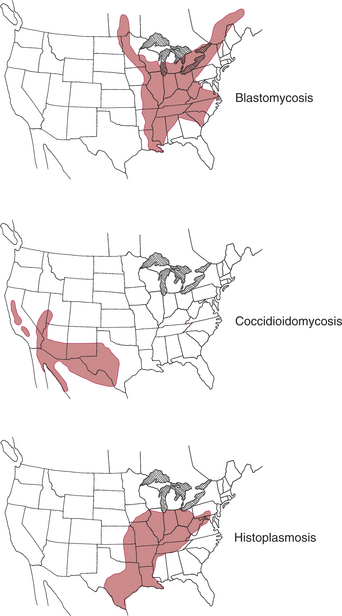Chapter 20 Systemic Mycoses
The four classical systemic mycoses of dogs and cats are histoplasmosis, blastomycosis, coccidioidomycosis, and cryptococcosis.
Fungal infections with a predilection for individual organ systems are discussed elsewhere; thus, for deep cutaneous fungal infections see Chapter 40, for dermatophytosis see Chapter 42, for intestinal pythiosis see Chapter 69, and for nasal aspergillosis see Chapters 160 and 163.
Histoplasmosis, blastomycosis, and coccidioidomycosis are endemic to defined regions of North America (Fig. 20-1).
HISTOPLASMOSIS
Etiology
Pathogenesis
Clinical Signs
Chronic Pulmonary Infection
Chronic pulmonary histoplasmosis is more common than the acute form and is characterized by chronic granulomatous pneumonia (diffuse or multifocal) with marked perihilar tracheobronchial lymphadenopathy that compresses the bifurcation of the trachea and mainstem bronchi. Clinical signs include chronic cough, exercise intolerance, and mild dyspnea with variable weight loss and fever. Radiographically, massive enlargement of the perihilar tracheobronchial lymph nodes and variable linear or nodular interstitial infiltrates are seen.
Intestinal Infection
Diagnosis
Hematology
Serum Chemistry Evaluations
Radiography and Ultrasonography
Thoracic Radiography
Serology
Cytology
Respiratory Cytology
Use bronchoalveolar lavage, tracheobronchial washings, or fine-needle lung aspirates.
Culture
Most specimens for cytologic or biopsy identification of Histoplasma are also suitable for culture. The Histoplasma mycelial phase grows on Sabouraud’s dextrose at room temperature in 7 to 10 days, and the yeast phase grows on blood agar from 30°C to 37°C. Use a diagnostic laboratory instead of in-clinic culturing, because fungal growth is potentially infectious for humans and poses a biohazardous risk to personnel.
Treatment
BLASTOMYCOSIS
Etiology
Clinical Signs
Disseminated Infection
Diagnosis
Hematology and Serum Chemistries
Cytology and Biopsy
Stay updated, free articles. Join our Telegram channel

Full access? Get Clinical Tree



